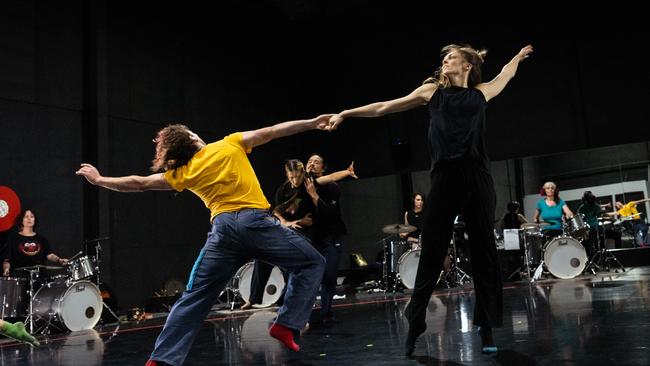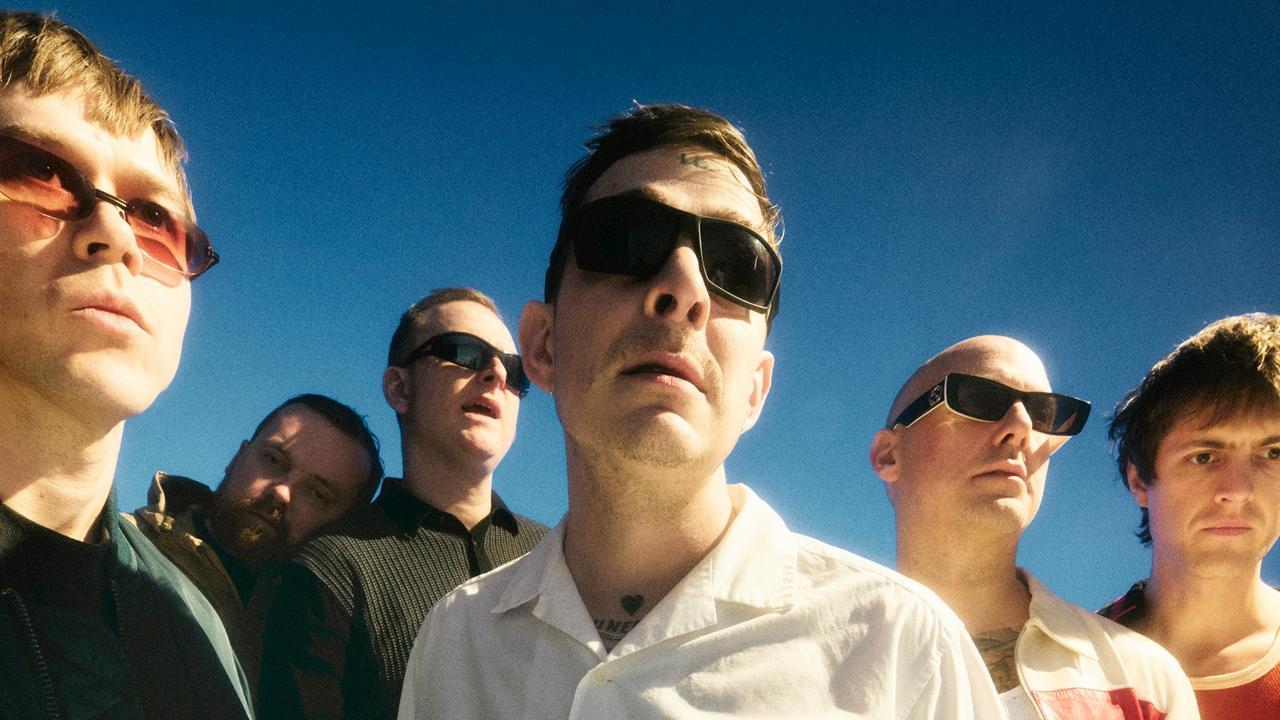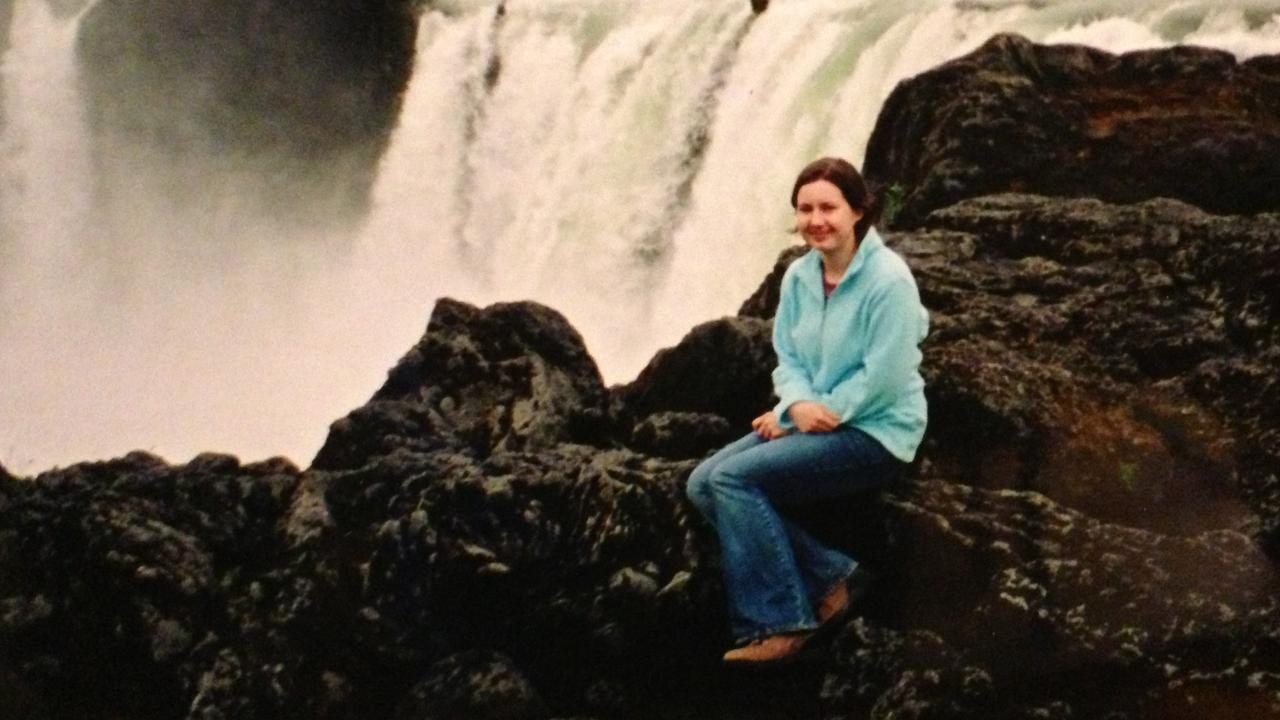Stephanie Lake’s Manifesto
The nine drummers and nine dancers in choreographer Stephanie Lake’s new work could bring the catharsis we need right now.

Stephanie Lake loved to dance when she was little. She’d flounce around in the leotards her parents gave her, trying out all sorts of moves.
“I was making up dances for my parents,” she recalls now. “I remember dancing in the basement, because every house has a basement in Canada, and thinking that I had invented the jeté. I can remember jumping through the air and thinking, ‘Oh my God!’ and repeating it over and over. I must have been about five or six.”
A little later, Lake was in the children’s dance group the Baha’i Faith she grew up in sent out to evangelise in the streets, a little like the Salvation Army with its brass bands. She used to make up some of their dances too.
Today, Lake is one of Australia’s finest choreographers: edgy, idiosyncratic, with a style honed as much from those early days as from the great choreographic lineage that entered her muscle memory in her 20 years of professional dancing.
She danced with Lucy Guerin, with Gideon Obarzanek at Chunky Move, with Phillip Adams at BalletLab, and through them absorbed the influences of Pina Bausch, Trisha Brown and more.
But dancers, like the elite athletes they most resemble, have a short working life and throughout those years she was heading towards her own career in choreography. And her esteem for those influences has only grown.

“I think I railed against it in the early years because when you’re dancing a lot for someone else it kind of infects your body. And so when you go to make your own movement, those physical pathways are there in your muscle memory and it’s hard to shake that off.”
No one could accuse Lake of being derivative today. Manifesto, which premieres at the Adelaide Festival in March, shows how far down her path she has travelled. Nine drummers and nine dancers perform what she calls “probably my least cerebral work”. It’s loud, pure sound and energy, she says, even though she hasn’t yet had to resort to earplugs in rehearsal.
She worked on it with her life partner, Robin Fox, a composer and visual artist who creates large-scale laser works.
“The force of the sound is so cathartic, I really love it. It’s a big, big sound, but the show has so many hills and valleys, and so many soft, tender moments, that when the force of the sound comes in all its fullness, you kind of want it. You crave it.
“So it’s drumming and dancing, but it’s the opposite of militaristic,” she adds. “It’s like we’re marching for peace or solidarity or something. I just wanted to make a really optimistic work, this big surge of sound and dancing that would just lift people out of their chairs.”
You can take the girl out of the religious movement but you can’t take the movement out of the girl.
Lake grew up in Saskatchewan. Her father is the Canadian poet, Allan Lake, and a teacher. Her mother Brenda, who is Scottish, was a stay-at-home mother when Lake was young but is creative too and would have loved to be a dancer, Lake thinks.
They met in Ibiza, which is not the wild place it is now, she says, laughing, when I compare and contrast that place with their religious conviction. “They were total hippies on the spiritual search, doing their own thing,” she says.

When she was eight and had “a little Canadian accent” as she cutely puts it, the family moved to Australia. It was utterly spontaneous. Despite being Scottish and knowing cold, her mother had tolerated as many Canadian winters as she could take. “They kind of looked at a map and pointed at Tasmania and went, ‘Let’s go there’,” Lake says.
They had three small children, with Lake the eldest. “It just blows my mind now that I have kids of my own. It’s just, it’s just unthinkable.”
It was partly restlessness. “And partly they were wanting to go somewhere where they could be of use, you know, and Tasmania was that for them.”
Missionaries for Tasmania? “It can be anywhere,” she says. The youth dance group she was in would make dances based on the “principles of the faith”, such as anti-racism and the equality of men and women – principles that need spreading everywhere.
“We danced in the mall and in the streets and tried to attract people. I mean, it makes me cringe a bit now, to be honest,” she says.
When she was 17, Lake took off on what they called their “year of service”. She was part of a youth dance troupe that travelled through Hungary and Israel.
“That year was pivotal for me. I mean, you grow up a lot when you go travelling overseas as a 17-year-old. And this is before the internet, when you saved up coins in the currency of the country you were in to call home every few weeks. My eldest daughter is 17 now and the thought of her doing that is pretty baffling.”
Questioned about the age of her daughters because she looks so young – “I don’t look so young close up,” she says with her ready laugh – she admits she is 47. She explains, too, that the girls are from an earlier marriage.
When she returned, she took up an apprenticeship with Tasdance, still the only professional dance company in Tasmania. She did a year sweeping their floors and sending their faxes in exchange for attending class and understudying the dancers. “I got really lucky and ended up performing and touring and basically being a company member for that year, which was the best possible training,” she says.

She mooched around for a year after that, working in sandwich shops and supermarkets and trying to sort out what to do next. She decided on VCA in Melbourne where, she says, she felt like the “grandma” in her class. “I was kind of a mature-age student, even though I was only 19 or something. But I felt incredibly old because I was in there with 16- and 17-year-olds who had just come straight out of school and had no life experience in my eyes.”
Her first year was hard. Practising her pliés and tendus bored her. “It was just training, training, training.” She almost quit, but her parents talked her out of it. They told her just to finish the semester to keep things symmetrical.
“I remember going away that summer and having a bit of a hard chat with myself. ‘You have to keep going,’ I told myself. ‘And if you’re going to keep going, you’re going to be the best in the class. You’re going to work your arse off.”
It paid off. It led to years of work with some of Australia’s finest contemporary dance companies, where Lake honed her technique. She still remembers her first professional pay cheque. “I just was so thrilled,” she says. “I remember handing it over to the bank teller and thinking ‘She’s probably never seen a cheque this big!’”
And her passion for choreography grew. In 2013, she was appointed the inaugural resident director of Lucy Guerin Inc and worked as Guerin’s choreographic assistant at the Lyon Opera Ballet. She eventually went freelance, her reputation bloomed and her works have since been performed as far afield as Germany and China, Denmark and Singapore.
The coronavirus epidemic might have made it easier for an internationally lauded artist to have family time, but it did make mincemeat of her diary. Another new piece, Monsters, which was to be headlined by the actor Pamela Rabe, had been scheduled for Malthouse Theatre in Melbourne last August. It was cancelled during the lockdown, though the theatre plans to premiere it soon.
Colossus, a work with 50-plus dancers, did go ahead in Paris at the Théâtre National de la Danse, Chaillot, last June however. Unable to leave Melbourne because of its lockdowns and our closed borders, Lake found a way to make it happen. Zoom came to the rescue and she taught the dancers their moves from a small studio near home. It was the third time a Lake work had been staged at the Chaillot: the first was in the basement, the second in the medium-sized theatre. “This was just such a dream, a life highlight, to have it at the absolute premier venue for dance, probably in the world, and we were on the main stage.”
She is doing the same now with 58 dancers in Hong Kong, where Colossus will be presented at the international arts festival there at the beginning of March. She says she has found the long-distance work difficult and exhausting, but it’s been one of the most “amazing” experiences of her life.
She can’t speak for the dancers, she says, “but from what I’ve heard it’s absolutely exhilarating to be on stage with 50 dancers. That never happens. It’s completely full of dancers, and you’re in close proximity and navigating that space together, and I think it’s just euphoric for them”.
The irony: a choreographer, expert at manipulating the muscle and sinew of human bodies, having to do it virtually, through cyberspace.
Manifesto runs as part of Adelaide Festival, March 17-20 and as part of RISING in Melbourne, June 9-12.



To join the conversation, please log in. Don't have an account? Register
Join the conversation, you are commenting as Logout